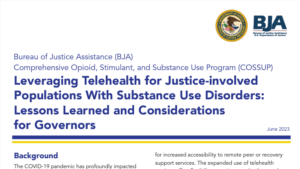This brief reviews activities undertaken by states to expand the use of telehealth for justice-involved individuals with SUDs during the COVID-19 pandemic, share lessons learned, and highlight considerations for Governors who wish to leverage telehealth services to increase access to SUD treatment for those involved in the justice system.
The COVID-19 pandemic has profoundly impacted the health outcomes of individuals with substance use disorders (SUDs). At its onset, the pandemic disrupted access to much-needed in-patient treatment options; social distancing measures and drug supply chain difficulties further isolated individuals and often led to riskier drug use behaviors, such as buying drugs off the street and using them alone. The pandemic exacerbated the already rising number of overdose deaths, contributing to more than 100,000 deaths in the 12-month period ending in April 2021.
Recognizing the need to improve health care service delivery during the pandemic, federal and state governments acted to expand access and remove barriers to telehealth services for individuals receiving treatment for SUDs. These actions included loosening restrictions for the prescription of medications for opioid use disorder, such as methadone and buprenorphine, and removing geographic limitations on access to behavioral health care using telehealth. Telehealth services also allowed for increased accessibility to remote peer or recovery support services. The expanded use of telehealth services offers flexibility to patients and enhances the likelihood that treatment will continue when in-person engagement is difficult to access.
Despite the expansion of telehealth services during the COVID-19 pandemic, there is still an ongoing need to improve care for justice-involved individuals living with SUDs. Within this population, the need for effective and affordable behavioral health treatment is critical. Almost two-thirds of people currently incarcerated in the United States have an SUD. Research also shows that drug overdose is the leading cause of death after release from prison, with overdoses being significantly more likely to occur within the first 2 weeks postrelease. Despite this, justice-involved individuals have historically had difficulties accessing treatment for SUDs and co-occurring behavioral health disorders. These difficulties can be mitigated by the benefits provided by telehealth, which include increased access to care for patients, reduced stigma, improved safety for staff, cost reductions for correctional institutions, and overall improvements to quality of care.
This brief reviews activities undertaken by states to expand the use of telehealth for justice-involved individuals with SUDs during the COVID-19 pandemic, share lessons learned, and highlight considerations for Governors who wish to leverage telehealth services to increase access to SUD treatment for those involved in the justice system.














